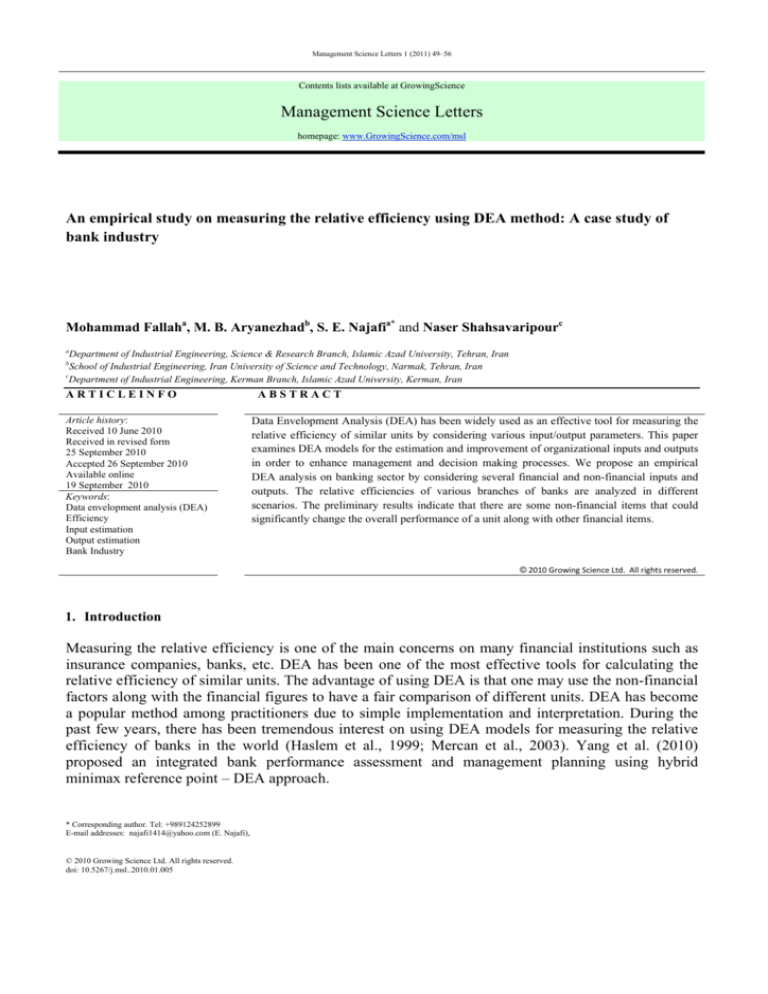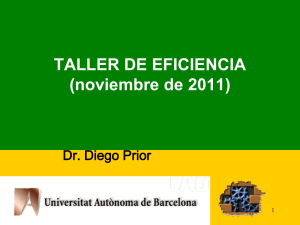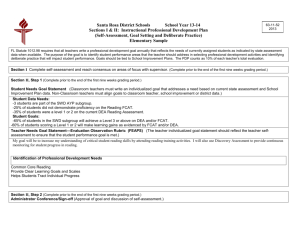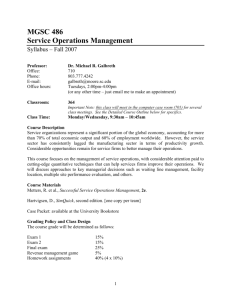
Management Science Letters 1 (2011) 49–56
Contents lists available at GrowingScience
Management Science Letters
homepage: www.GrowingScience.com/msl
An empirical study on measuring the relative efficiency using DEA method: A case study of
bank industry
Mohammad Fallaha, M. B. Aryanezhadb, S. E. Najafia* and Naser Shahsavaripourc
a
Department of Industrial Engineering, Science & Research Branch, Islamic Azad University, Tehran, Iran
School of Industrial Engineering, Iran University of Science and Technology, Narmak, Tehran, Iran
c
Department of Industrial Engineering, Kerman Branch, Islamic Azad University, Kerman, Iran
b
ARTICLEINFO
Article history:
Received 10 June 2010
Received in revised form
25 September 2010
Accepted 26 September 2010
Available online
19 September 2010
Keywords:
Data envelopment analysis (DEA)
Efficiency
Input estimation
Output estimation
Bank Industry
ABSTRACT
Data Envelopment Analysis (DEA) has been widely used as an effective tool for measuring the
relative efficiency of similar units by considering various input/output parameters. This paper
examines DEA models for the estimation and improvement of organizational inputs and outputs
in order to enhance management and decision making processes. We propose an empirical
DEA analysis on banking sector by considering several financial and non-financial inputs and
outputs. The relative efficiencies of various branches of banks are analyzed in different
scenarios. The preliminary results indicate that there are some non-financial items that could
significantly change the overall performance of a unit along with other financial items.
© 2010 Growing Science Ltd. All rights reserved.
1. Introduction
Measuring the relative efficiency is one of the main concerns on many financial institutions such as
insurance companies, banks, etc. DEA has been one of the most effective tools for calculating the
relative efficiency of similar units. The advantage of using DEA is that one may use the non-financial
factors along with the financial figures to have a fair comparison of different units. DEA has become
a popular method among practitioners due to simple implementation and interpretation. During the
past few years, there has been tremendous interest on using DEA models for measuring the relative
efficiency of banks in the world (Haslem et al., 1999; Mercan et al., 2003). Yang et al. (2010)
proposed an integrated bank performance assessment and management planning using hybrid
minimax reference point – DEA approach.
* Corresponding author. Tel: +989124252899 E-mail addresses: najafi1414@yahoo.com (E. Najafi),
© 2010 Growing Science Ltd. All rights reserved.
doi: 10.5267/j.msl..2010.01.005
50
Staub et al. (2010) studied different factors affecting the relative efficiency of Brazilian banks such as
cost and technical efficiencies for a time period between the years of 2000 to 2007. They reported
that Brazilian banks suffered from low levels of efficiency compared with European or North
American banks. They also reported that state-owned banks were significantly more cost efficient
than other foreign banks. However, they did not find any evidence to claim that the differences in
economic efficiency were due to the type of activity and bank size. Avkiran (2010) studied the
relationship between the supper-efficiency estimations and some major key financial ratios for some
Chinese banking sector. The method provides some opportunity to detect the inefficient units where
there is a low correlation between the supper-efficiency and good financial ratios. Lin et al. (2009)
performed different DEA models for 117 branches of a certain bank in Taiwan and reported an
overall technical efficiency of 54.8 percent for all banks. The results of their survey also showed that
most branches were relatively inefficient. Thoraneenitiyan and Avkiran (2009) surveyed the
implementation of an integrated DEA and SFA to measure the impact of restructuring and countryspecific factors on the efficiency of post-crisis east Asian banking systems from 1997 to 2001. They
reported that banking system inefficiencies were mainly attributed to country-specific conditions,
such as high interest rates, concentrated markets and economic development. DEA was also used for
banking decisions. For instance, Che et al. (2010) used a combination of Fuzzy analytical hierarchy
procedure (AHP) and DEA as a decision making facility for making bank loan decisions.
This paper is organized as follows. We first present the problem statement of DEA method in section
2. Section 3 presents an in-depth discussion of different DEA models for input and output estimation
together with efficiency improvement and mathematical calculation methods. We present the
implementation of the DEA approach for banking sector in section 4. Finally, concluding remarks are
given in the last section to summarize the contribution of the paper.
2. Data Envelopment Analysis
The constant return to scale DEA (CCR) was first proposed by Charnes, et al. (1978, 1994) as a
mathematical tool for measuring the relative efficiency of decision making units (DMU). One may
easily understand how a given DMU works whenever a production function is available. However, in
many cases obtaining an analytical form for this function is not possible. Therefore, we form a set of
production feasibility which constituts of some principles such as fixed-scale efficiency, convexity
and feasibility as follows,
n
n
⎧
⎫
TC = ⎨( X , Y ) X ≥ ∑ λ j X j , Y ≤ ∑ λ j Y j , λ j ≥ 0, j = 1,L n ⎬ ,
j =1
j =1
⎩
⎭
(1)
where X and Y represent the input and output vectors, respectively. The CCR production feasibility
set border defines the relative efficiency in which any off-border DMU is regarded as inefficient. The
CCR model can be determined in two forms of either input or output oriented. The input CCR aims to
decrease the maximum input level with a ratio of θ so that, at least, the same output is produced, i.e.:
θ
subject to
min
n
θX p − ∑ λ j X ij ≥ 0,
j =1
(2)
n
∑ λ j Yrj ≥ Yrp ,
j =1
λ j ≥ 0,
j = 1,L, n.
Model (2) is called envelopment form of input CCR where θ is the relative efficiency of the DMU
and it is an easy assignment to show that the optimal value of θ , θ*, is always between zero and one.
M. Fallah et al. / Management Science Letters 1 (2011)
51
In an input oriented DEA model, once the efficiency of a DMU unit, DMU p , drops in case of
inefficiency, one may directs it towards the border to make it efficient. In the case of the output
oriented DEA model, the primary aim is to maximize the output level, ϕ , by using the same amount
of input. The model can be formulated as follows,
ϕ
subject to
min
n
∑ λ j X ij ≤ X ip ,
(3)
j =1
n
∑ λ jY j ≥ ϕYip ,
j =1
λ j ≥ 0,
j = 1,L, n.
3. DEA Models for Estimating and Improving Inputs and Outputs
3.1 Output estimation
Consider n different DMUs as {DMUj : j=1,...,n} using m inputs to generate s outputs. Let y ri and xij
be the rth output, r = (1,L, s ) and the ith input, i = (1,L m) of the jth DMU, j = (1,L n), respectively.
Let ϕ * be the efficiency level of the DMUp where it has a value of one or higher, i.e. the measured
unit is either efficient or inefficient. Suppose that we increase the inputs of DMUp from xp to
α ip = xip + Δxip where Δx p ≥ 0 and Δx p ≠ 0 and we want to know how much output DMUp would be
generated. That is we want to estimate the output vector yrp ( new) = ( y1 p ( new) , y2 p ( new) ,... y sp ( new) ) , where we
present them as β rp = ( β1 p , β 2 p ,...β sp), for the sake of the simplicity. We also consider two conditions
for our problem statement. First, it is assumed that as the inputs increase, ϕ * remains unchanged and
second, it is assumed that as the inputs increase the efficiency will also increase. If efficiency increase
is not the target and the efficiency of DMUp remains at ϕ * , the outputs of the measured unit can be
calculated by solving the following,
max
β p = ( β1 p ,L, β sp )
subject to
n
∑ λ j X ij ≤ α ip
j =1
(4)
n
∑ λ j Yrj ≥ ϕ *p β p
j =1
β p ≥ Yp
λj ≥ 0
j = 1...n.
Model (4) is a multi-purpose problem to solve where we may assign relative weights ( w p ) to each
output ( yip ) using a multiple criteria decision making methods such as AHP. Let
s
β rp = ( β1 p , β 2 p ,...β sp ) = ∑ wr β rp . Therefore we have,
r =1
s
max
β p = ( β1 p ,L, β sp ) = ∑ wr β rp
r =1
subject to
n
∑ λ j X ij ≤ α ip
j =1
52
(5)
n
∑ λ j Yrj ≥ ϕ *p β p
j =1
β p ≥ Yp
λj ≥ 0
j = 1...n.
Let Δx p be the increase on the inputs of unit p and η be the percentage of the increase on ϕ * . In order
to obtain the output for unit p we may replace ϕ * with (1 − η )ϕ * in (5) which yields,
100
s
max
β p = ( β1 p ,L, β sp ) = ∑ wr β rp
r =1
subject to
n
∑ λ j X ij ≤ α ip ,
j =1
∑ λ j Yrj ≥ [(1 − η / 100)ϕ ∗p ]β p ,
(6)
n
j =1
β p ≥ Yp ,
λj ≥ 0
j = 1...n.
3.2 Input estimation
Let θ * be the optimal efficiency value of the DMU measured by model (2) and we intend to increase
the production of DMUp by Δy p ≥ 0 , that is y rp ( new) = β rp = y rp + Δy rp . Assuming a constant efficiency
of the measured DMU we can estimate the inputs of the unit p with similar approach given in the
previous section. Let xip ( new) = ( x1 p ( new) , x2 p ( new) ,...x mp ( new) ) = α ip = (α1 p ,α 2 p ,...α mp ) and to simplify the
solution
of
the
multi-purpose
function,
one
may
rewrite
the
target
function
as
m
α ip = (α 1 p , α 2 p ,...α mp ) = ∑ wiα ip and solve the following model,
i =1
m
min α ip = (α1 p , α 2 p ,...α mp ) = ∑ wiα ip
i =1
subject to
n
∑ λ j X ij ≤ θ *α ip
i = 1...m
(7)
j =1
n
∑ λ j Yrj ≥ β rp
r = 1...s
j =1
α ip ≥ xip
λj ≥ 0
j = 1...n.
Let δ be the percentage increase in efficiency of θ * resulted when the outputs are increased. Let θ *
is replaced with
(1 +
δ
100
)θ *
. Therefore we have,
m
min α ip = (α1 p , α 2 p ,...α mp ) = ∑ wiα ip
i =1
subject to
n
∑ λ j X ij ≤ (1 + δ / 100)θ *α ip
j =1
n
∑ λ j Yrj ≥ β rp
j =1
r = 1...s
i = 1...m
(8)
M. Fallah et al. / Management Science Letters 1 (2011)
α ip ≥ xip
λj ≥ 0
53
j = 1...n.
However, if the amount of efficiency increase is not specified and the measured organization requires
such increase as a precondition for increase in the outputs, then the input estimation of model (7) will
be changed to model (8) where θ ≥ θ * is an additional condition.
4. Analysis and Results
In this section we present the details of our DEA implementation for an Iranian banking system. The
data for the input and the output are collected for the fiscal year of 2006. The study uses four inputs
and six outputs shown in Fig. 1.
Incentive costs
Cost to Revenue
DMU
(Banks)
Outstanding bad loans rate
Assets Growth rate
Return on Equity
Profit Margin
Market Share or customer attraction rate
Online Services
Electronic Services
Advanced Services
Fig. 1. The input and the output of DEA model
The input data for all ten units are summarized in Table 1 where the first column represents the
number of electronic services in terms of the number, the second column shows the percentage of the
incentive costs, the thirst column depicts the ratio of cost to income in terms of the percentage and the
last column provides the information of the rate of the outstanding bad loans.
Table 1
The necessary input data
DMU
Electronic services
1
1305
2
1906
3
1758
4
1500
5
745
6
517
7
957
8
1310
9
982
10
793
Incentive costs
23.03
18.72
18.50
5.30
17
3
16
21
17
13
Cost/Income
52.84
42.77
60
60.2
57.90
96
72
83
48
51
Outstanding bad loans rate
2.68
9.5
15
8.5
7.3
14
7.8
10
9.5
6.5
The output data are also tabulated in Table 2 where the first column shows the online services in
terms of the number, the second column represents the number of advanced services, the third column
provides the growth rate of assets, the fourth column specifies the rate of growth margin and the last
column shows the growth in market share to absorb new customers.
54
Table 2
The output information
DMU Online services
1
2
3
4
5
6
7
8
9
10
1376
1560
1842
1315
787
409
650
1120
980
784
Advanced
services
74
57
8
37
34
10
18
36
28
37
Assets growth rate Investment
return
17.42
4.81
12.98
7.16
47.59
7
18.9
1.4
20.13
1.23
10.28
1.02
12.10
1.4
18
3.5
15
2.5
23.5
1.6
Profit
margin
1.48
2.62
8
2.7
3
4
2.8
3.8
5.3
1.9
Customer
attraction rate
22.91
25.8
29
34.50
21.8
13
18
21
19
21
Applying the DEA models explained in the previous section yields the relative efficiencies of
different units in two different cases. Table 3 summarizes the results of the efficiency estimation in
two cases of input and output based.
Table 3
Efficiency measurement results
DMU
Output oriented efficiency
Input oriented efficiency
1
1
1
2
1
1
3
1
1
4
1.182
0.845
5
1
1
6
1
1
7
1.52
0.65
8
1.20
0.83
9
1
1
10
1
1
As we can observe from Table 4, there are three inefficient units of 4, 7 and 8 when we solve the
system based on the output oriented system and the rest of them are located on efficient frontier
which means they are efficient. Since we use only four inputs we can change their values to find out
how to make the inefficient unit efficient. We have performed this analysis in different cases and the
following is the summary of our experience.
Table 4
The relationships between the number of electronic services and asset growth
Electronic services
1400 1450 1500 1550 1600
1650
1700
Asset growth rate
0.189 0.189 0.237 0.249 0.26
0.27
0.284
1750
0.296
1800
0.308
We have studied the relationship between the online services and the growth rate on assets. Table 4
summarizes the results of our survey. As we can observe from Table 4, when the number of
electronic services is limited to 1400, we could expect approximately 19 percent of growth on banks'
assets. However, when we increase the number of services from 1400 to 1900 we could expect an
over 30 percent growth on our assets. In other word, an increase on electronic services could
significantly contribute to asset growth. We have also studied the relationship between the electronic
service, as an input element, and online service as output factor. Table 5 summarizes the details of
our survey between these two items. As we can see, an increase to the number of electronic services
could also contribute to the number of online services. In other word, a 400 increase on the number of
electronic services could result to an increase of about 268 online services.
Table 5
The relationships between the number of electronic services and the number of online services
Electronic services
1400 1450 1500 1550 1600
1650
1700
1750
1800
Online Services
1315
1315
1358
1401
1445
1487
1530
1530
1573
M. Fallah et al. / Management Science Letters 1 (2011)
55
Another interesting issue is to study the relationship between the efficiency and the growth on assets.
Table 6 shows the details of our study on these two factors for DMU 4.
Table 6
The relationships between the efficiency and the asset growth rate
1.182 1.175 1.15
1.125 1.1
1.075
Efficiency ( θ )
1.05
1.025
1.00
Asset growth rate
0.31
0.326
0.343
0.237
0.24
0.253
0.266
0.28
0.295
As we can observe from Table 6 when unit 4 is completely inefficient with θ = 1.182 the average
growth on total assets is limited to 0.237. However, we can expect an over 10 percent increase on
asset growth when unit 4 becomes efficient. There is also a similar pattern on the number of online
services and the efficiency of this unit which is shown on Table 7.
Table 7
The relationships between the efficiency and the asset growth rate
1.182 1.175 1.15
1.125 1.1
1.075
Efficiency ( θ )
1.05
1.025
1.00
Online services
1485
1523
1562
1315
1323
1353
1384
1416
1450
One of the most important observations is the strong relationship between the efficiency and the
number of online services. As we can learn from Table 7, when θ = 1.182 for unit 4, the number of
online services is limited to only 1315. However, an increase of only 247 online services makes the
unit efficient.
Table 8
The effects of simultaneous changes on input/output parameters for unit number four
Asset
Investment Profit
Customer
Online
Growth
Return
Margin
Attraction
Services
Rate
rate
0.237
0.014
0.027
0.345
1315
Φ = 1.182
Electronic
Service = 1500
Outstanding bad
loan rate = 0.085
0.318
0.014
0.027
0.345
1453
Φ = 1.15
Electronic
Service = 1600
Outstanding bad
loan rate = 0.1
0.387
0.014
0.027
0.382
1582
Φ = 1.1
Electronic
Service = 1650
Outstanding bad
loan rate = 0.12
0.419
0.014
0.027
0.409
1667
Φ = 1.08
Electronic
Service = 1700
Outstanding bad
loan rate = 0.13
Advanced
Services
37
37
37
37
56
The other interesting issue is to study the effects of the simultaneous changes on different input and
output parameters on the efficiency ratio. We have made different changes on two input parameters
as well as six output factors and the results are summarized in Table 8.
As we can observe from Table 8, it is possible to increase the efficiency of unit four even when the
input parameters are increased. This could be done by hiking the number of online services as well as
trying to have a better customer attraction rate.
5. Conclusion
The present study has attempted to examine different DEA models for the estimation and
improvement of organizational inputs and outputs in order to enhance management and decision
making processes. The results of this survey show that financial figures such as profit margin and
return on equity are not the only signals of performance measurement and there are other nonfinancial characteristics that could affect the efficiency of a bank such as the number of online
services, electronic services, etc. The study also emphasizes that there is a strong relationship
between some non-financial and financial items such as financial asset growth and electronic
services.
Acknowledgment
The authors would like to thank the anonymous referees for their comments on the earlier version of
this work.
References
Charnes A, Cooper, W. W., Rhodes, E. (1978). Measuring the efficiency of decision making units.
European Journal of the Operational Research, 2, 429–44.
Charnes A, Cooper W. W., Lewin, A., Seiford, L. M. (1994). Data envelopment analysis: theory,
methodology and applications. Massachusetts: Kluwer Academic Publishers.
Staub, R. B., Da Silva e Souza, G. & Tabak, B. M. (2010). Evolution of bank efficiency in Brazil: A
DEA approach. European Journal of Operational Research, 202(1), 204-213.
Avkiran, N. K. (2010). Association of DEA super-efficiency estimates with financial ratios:
Investingating the case for Chinese banks. Omega, doi:10.1016/j.omega.2010.08.001.
Lin, T. T., Lee, Ch-Ch., & Chiu, T-F. (2009). Application of DEA in analyzing a bank's operating
performance. Expert Systems with Applications, 36(5), 8883-8891.
Yang, J.B., Wong, B.Y.H., Xu, D.L., Liu, X.B. & Steuer, R.E. (2010). Integrated bank performance
assessment and management planning using hybrid minimax reference point – DEA approach.
European Journal of Operational Research, doi:10.1016/j.ejor.2010.07.001.
Thoraneenitiyan, N., & Avkiran, N. K. (2009). Measuring the impact of restructuring and countryspecific factors on the efficiency of post-crisis East Asian banking systems: Integrating DEA with
SFA. Socio-Economic Planning Sciences, 43(4), 240-252.
Che, Z. H., Wang, H. S., & Chuang, Ch-L. (2010). A fuzzy AHP and DEA approach for making bank
loan decisions for small and medium enterprises in Taiwan, Expert Systems with Applications,
37(10), 7189-7199.
Mercan, M., Reisman, A., Yolalan, R., & Burak Emel, A. (2003). The effect of scale and mode of
ownership on the financial performance of the Turkish banking sector: results of a DEA-based
analysis, Socio-Economic Planning Sciences, 37(3), 185-202.
Haslem, J. A., Scheraga, C. A., & Bedingfield, J. P. (1999). DEA efficiency profiles of U.S. banks
operating internationally. International Review of Economics & Finance, 8(2), 165-182.







